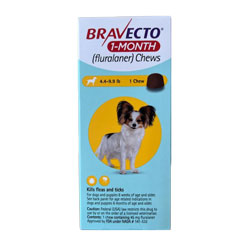Bravecto 1-MONTH Chew
Introducing BRAVECTO® 1-MONTH Chews— flea and tick protection for dogs and puppies.
Veterinarian Prescription (Rx) RequiredFree Shipping on orders over $75
Low Price Match Guarantee
- Kills adult fleas, and treats and prevents flea infestations (Ctenocephalides felis) Treats and controls tick infestations*
- Ixodes scapularis (black-legged tick)
- Dermacentor variabilis (American dog tick)
- Rhipicephalus sanguineus (brown dog tick)
- Amblyomma americanum (lone star tick)
- 100% EFFECTIVENESS against fleas for 30 DAYS In dogs 8 weeks of age and older.
- ≥97.7% EFFECTIVENESS against ticks at 48 hours for 30 DAYS In dogs 8 weeks of age and older against brown dog ticks.
Description
Introducing BRAVECTO® 1-MONTH Chews— flea and tick protection for dogs and puppies. Veterinary professionals well know, life with a puppy isn’t always picture perfect. In addition to all the cuteness, there comes some hard work and even the occasional fleas and ticks! That’s why choosing the right protection is so important. By prescribing BRAVECTO 1-MONTH Chews to your patients, no matter what life has in store, you can trust that they’ll be well-protected from the start.
Kills adult fleas, and treats and prevents flea infestations (Ctenocephalides felis) Treats and controls tick infestations*
- Ixodes scapularis (black-legged tick)
- Dermacentor variabilis (American dog tick)
- Rhipicephalus sanguineus (brown dog tick)
- Amblyomma americanum (lone star tick)
Dosage Schedule
Bravecto 1-Month should be administered orally as a single dose monthly according to the Dosage Schedule below to provide a minimum dose of 4.5 mg/lb (10 mg/kg) fluralaner. Bravecto 1-Month should be administered with food.
|
Body Weight Ranges (lbs) |
Fluralaner content (mg) |
Chews Administered |
|
4.4-9.9 |
45 |
One |
|
>9.9-22.0 |
100 |
One |
|
>22.0-44.0 |
200 |
One |
|
>44.0-88.0 |
400 |
One |
Important Safety Information
BRAVECTO 1-MONTH Chews are for dogs 8 weeks of age and older. Side effects may include itching, diarrhea, vomiting, decreased appetite, elevated ALT, lethargy, and weight loss. Fluralaner is a member of the isoxazoline class. This class has been associated with neurologic adverse reactions including tremors, ataxia, and seizures. Seizures have been reported in dogs receiving isoxazoline class drugs, even in dogs without a history of seizures. Use with caution in dogs with a history of seizures or neurologic disorders. BRAVECTO 1-MONTH Chews are not effective against A. americanum in puppies less than 6 months of age. BRAVECTO Chews for Dogs the most commonly reported adverse reactions include vomiting, decreased appetite, diarrhea, lethargy, polydipsia, and flatulence. BRAVECTO Chews for Dogs have not been shown to be effective for 12-weeks’ duration in puppies less than 6 months of age. BRAVECTO Chews are not effective against lone star ticks beyond 8 weeks of dosing. Fluralaner is a member of the isoxazoline class. This class has been associated with neurologic adverse reactions including tremors, ataxia, and seizures. Seizures have been reported in dogs receiving isoxazoline class drugs, even in dogs without a history of seizures. Use with caution in dogs with a history of seizures or neurologic disorders.







